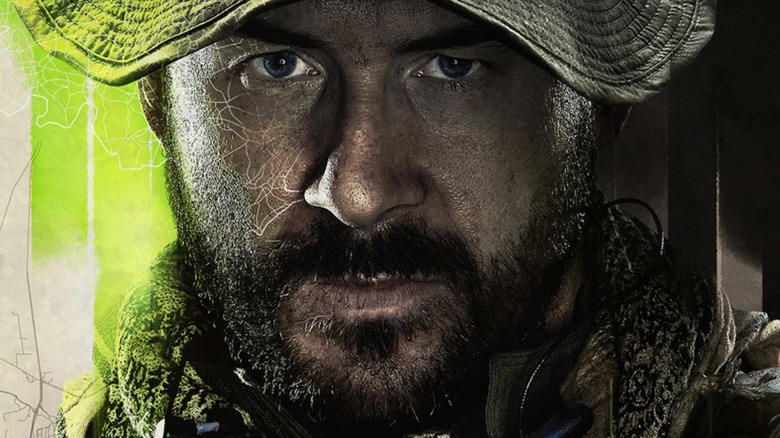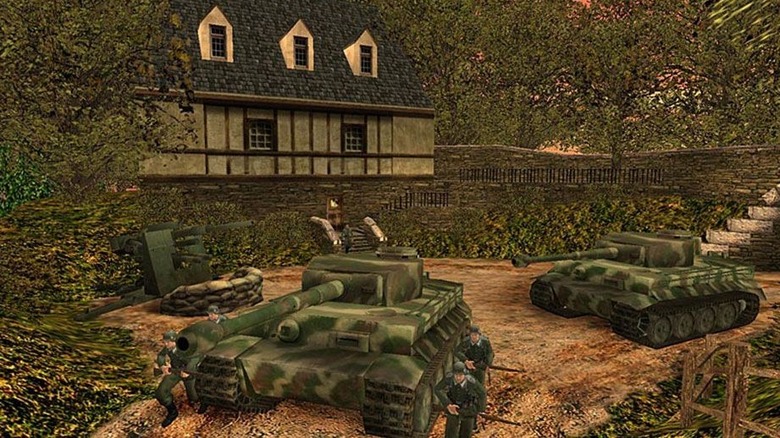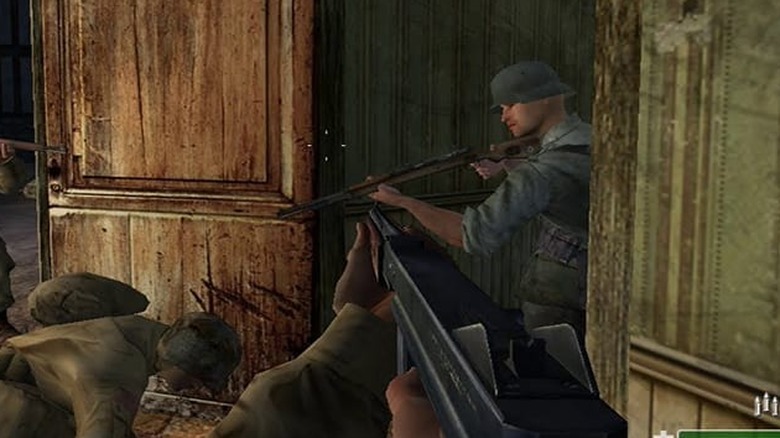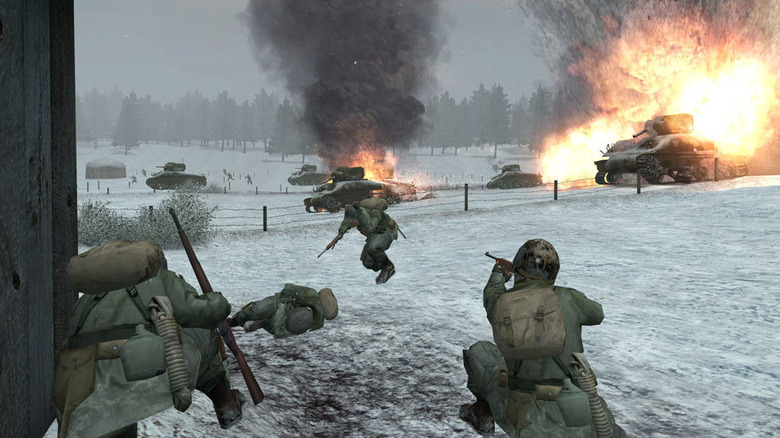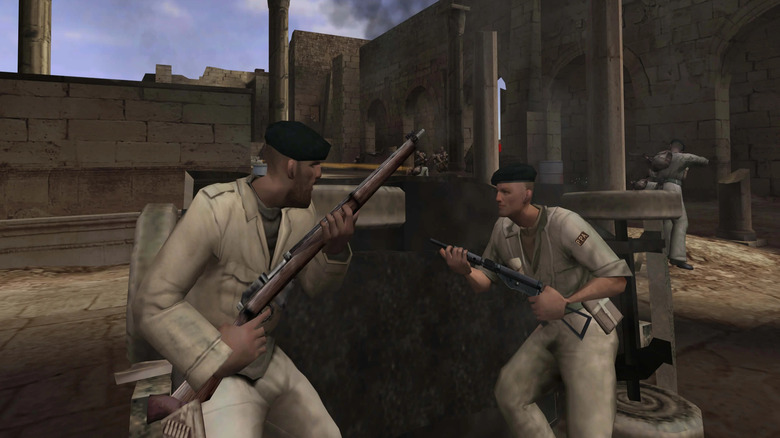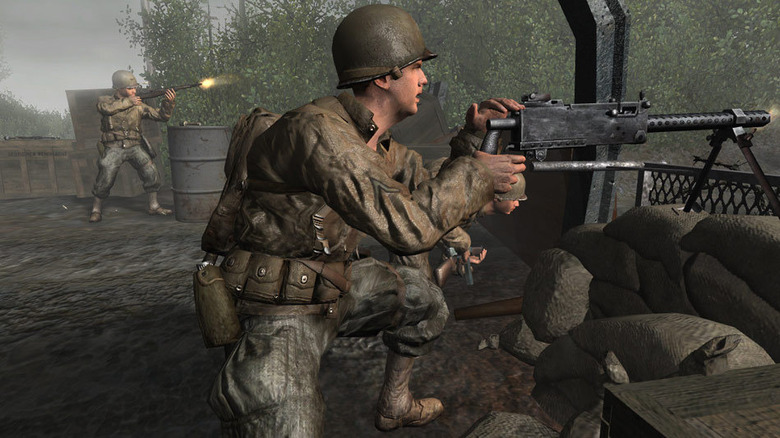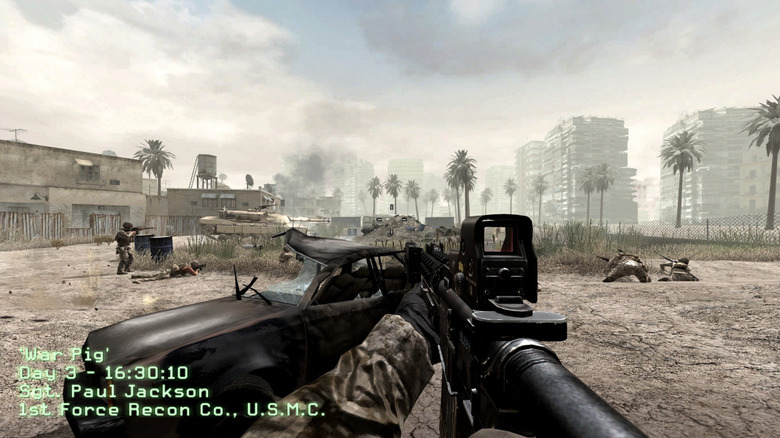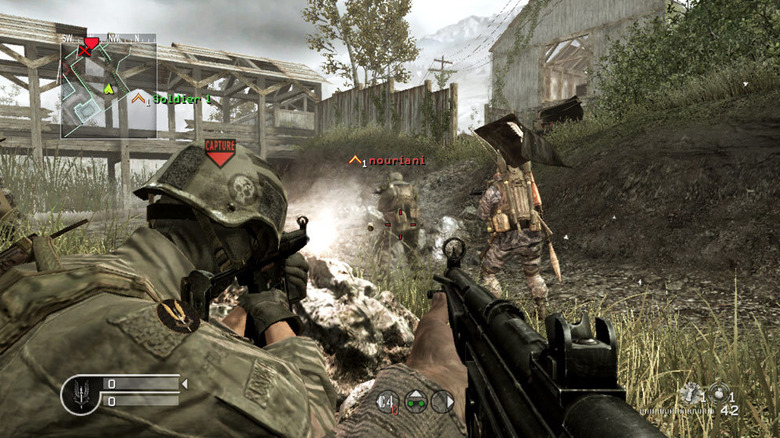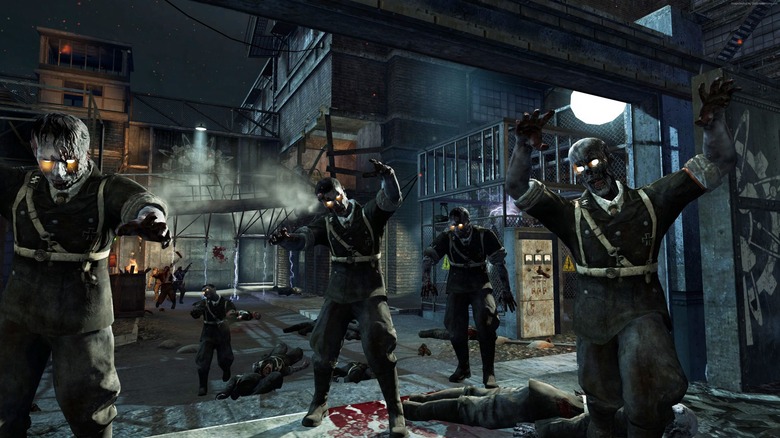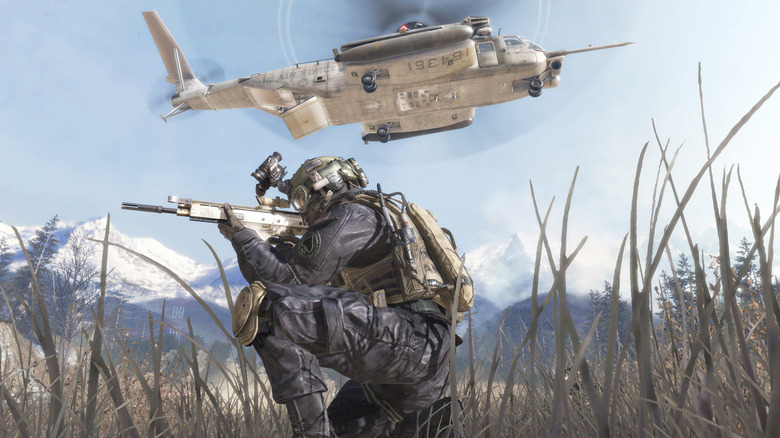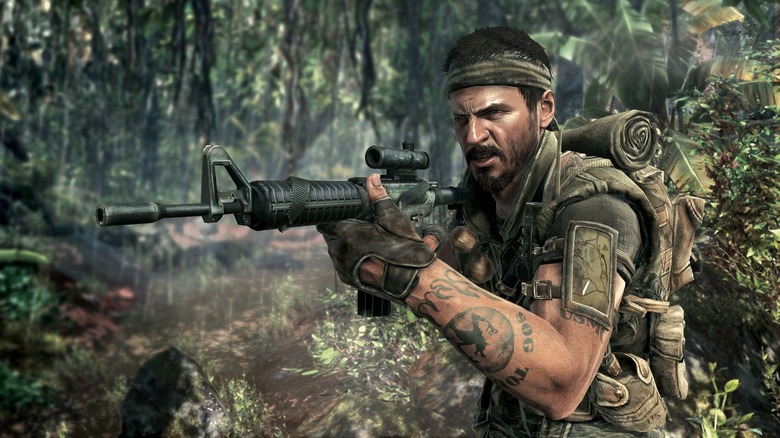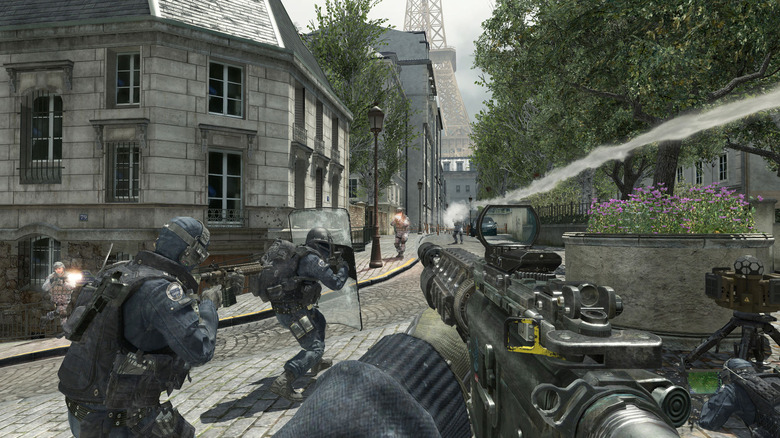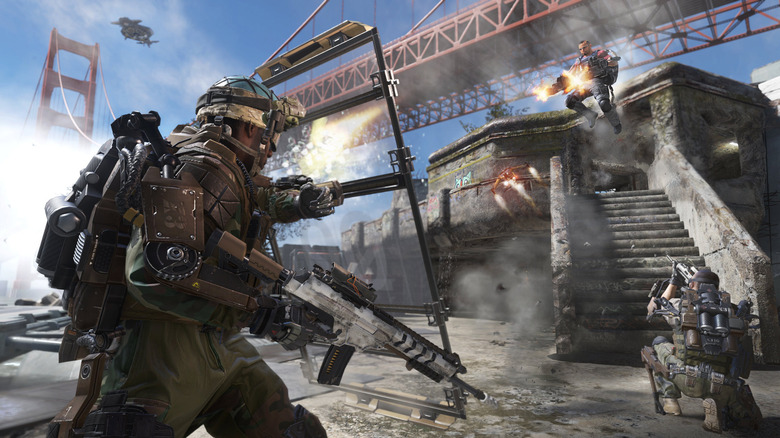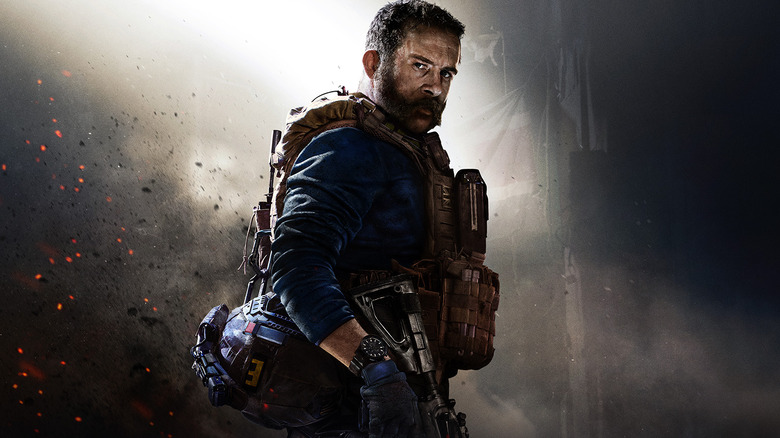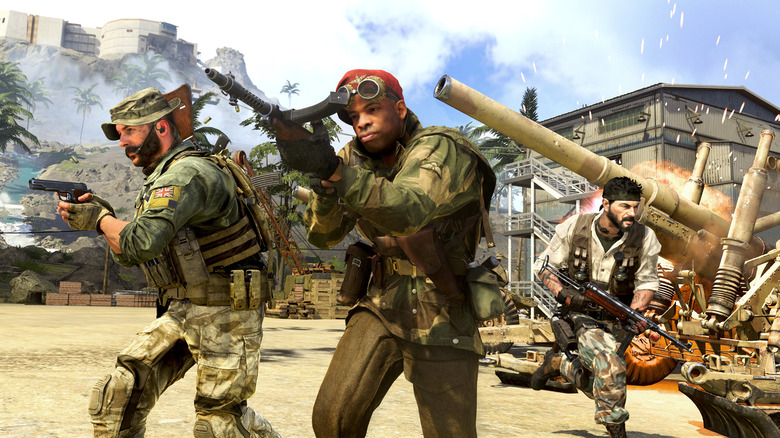How Call Of Duty Went From Medal Of Honor Clone To Yearly Success
Of all the first-person shooter franchises that have helped define the genre on both PC and home consoles, one that continues to loom large is "Call of Duty." Published by Activision, the video game series began in 2003 as a PC-exclusive title, and its initial wave of titles set during World War II before the franchise expanded to other platforms and time periods. A perennially popular series with a dedicated online multiplayer community and devoted fanbase, "Call of Duty" continues to serve as one of Activision's flagship franchises and a leader in the shooter genre.
What follows is a full history of the "Call of Duty" franchise across all of its major transformative moments, from its leaps forward in gameplay and availability to the series' experiments with narrative and setting. The "Call of Duty" series has evolved to become a bonafide gaming phenomenon and an industry juggernaut, and it's easy to see why.
Call of Duty was influenced by Medal of Honor
The "Call of Duty" franchise is predated four years by Electronic Arts' "Medal of Honor" series, and both games' initial installments are set during World War II. Unsurprisingly, the origins of "Call of Duty" are informed by "Medal of Honor," right down to the personnel involved on former series' inaugural title. 21 people on the original 2003 "Call of Duty's" production team previously worked together on 2002's "Medal of Honor: Allied Assault" before leaving to found their own company, which became Infinity Ward.
In an interview with GameSpot, Infinity Ward co-founder and CEO Vince Zampella explained that all the lead developers from "Allied Assault" reunited for "Call of Duty." To create their own distinct WWII gameplay experience, Infinity Ward used a modified "Return to Castle Wolfenstein" engine, which itself was a modified "Quake 3" engine. In contrast to "Medal of Honor," Infinity Ward wanted to focus on large-scale battles in which NPC allies were vital in supporting the player character. Essentially, the team wanted to create what they wanted to experience in a WWII game themselves.
The initial multiplayer mode was mod-friendly
"Call of Duty" began as a PC-exclusive title. At the time, console first-person shooters were still largely struggling to live up to their PC counterparts. With that in mind, Infinity Ward was very conscientious of its target audience when developing the multiplayer component to the game. This led to "Call of Duty" being intentionally developed with post-release modifications in mind, so its multiplayer mode would invite a community to form around the game.
In an interview with IGN, "Call of Duty" lead designer Zied Rieke explained that gameplay and multiplayer game modes were scripted in such a way that they were mod-friendly for savvy gamers. In the same interview, lead animator Michael Boon added that the game's scripting system was crucial for keeping track of characters and environmental assets. With this scripting system open on PC, players could create their own customized "Call of Duty" experiences to enjoy and share online.
Call of Duty's expansion revamps its multiplayer features
While the original "Call of Duty" was built around the "Return to Castle Wolfenstein" engine, the game's expansion went one step further by handing over development to Gray Matter, the actual makers of "Return to Castle Wolfenstein" (per IGN). The resulting project was 2004's "Call of Duty: United Offensive," which expanded upon the original game's single-player campaign and its multiplayer mode. Rather than just adding more levels and weapons, "United Offensive" significantly revamped the features available within multiplayer, several of which continue to play a prominent role in the franchise today.
Three new game modes were added, the most notable being Domination, a type of King-of-the-Hill prompt where players controlled a set point on the map to earn points. "United Offensive" also added a reward system as players racked up kills, giving them in-game perks, while the expansion also debuted vehicle functionality in multiplayer. All of these features would go on to be major recurring elements within the "Call of Duty" multiplayer experience as the franchise looked to expand beyond the PC market.
Cinematic storytelling and a console debut
"Call of Duty" didn't grace home consoles until 2004, when Spark Unlimited's "Call of Duty: Finest Hour" was released for the PlayStation 2, GameCube, and Xbox. Both the PS2 and Xbox versions featured online gameplay through their respective servers, while the Xbox's system link feature also allowed for LAN multiplayer gameplay. More than simply being a port of the original "Call of Duty" or "United Offensive," "Finest Hour" was a new game built from the ground up by the developers.
In an interview with IGN, "Finest Hour" producer and Spark COO Scott Langteau explained that the game made a conscious focus on individual characters across the single-player campaign. The developers felt this offered a more cinematically immersive experience to the player, as they got to know the characters over the course of the game's harrowing battles. With 28 members of Spark's staff having previously worked on the "Medal of Honor" franchise, the underlying DNA from the initial "Call of Duty" games was kept alive as it transitioned to consoles.
Call of Duty 2 ditches health bars and goes bigger
The first set of "Call of Duty" games echoed its contemporaries by giving players a set health bar, complete with health pickups available on most levels to help them recover from any damage. This was changed for 2005's "Call of Duty 2," which featured a health regeneration system, allowing players to gradually recover when they stopped taking damage. With Infinity Ward using its own proprietary game engine for the first time, "Call of Duty 2" offers players multiple paths to progress, moving away a bit from the more linear level progression in previous games.
Just as "Finest Hour" opened the door for the franchise to appear on consoles, "Call of Duty 2" was among the launch titles for the Xbox 360. The game became the bestselling launch title for the Microsoft console, sold at a staggering 77% attach rate for players purchasing the 360, with nearly six million copies sold in its lifetime (per The Ringer). Thanks to these gameplay changes and the franchise's success on the Xbox 360, "Call of Duty" was rapidly finding its own voice — and a growing audience.
Call of Duty leaps into the 21st century
Though all of the initial "Call of Duty" games were set during WWII, this changed dramatically with 2007's "Call of Duty 4: Modern Warfare." As implied by the title, the game was set in the 21st century, reflecting a facsimile of the geopolitical landscape at the time of its development. This bold leap, both in time period and gameplay, continues to define "Call of Duty" today, although the series has returned to its historical settings on occasion.
In an interview with GamesRadar, Infinity Ward President Grant Collier revealed the dramatic shift to a modern setting was one the developers had planned for a long time. In addition to providing 21st century environments and weaponry, the developers felt the time jump made for more immersive storytelling and narrative possibilities. In order to make the single-player experience more cinematic, Collier explained that the development team brought on established television writers to craft a more engaging story.
Modern Warfare overhauls the series' multiplayer
"Call of Duty" has always had a robust online multiplayer scene, but "Modern Warfare" made this gameplay feature into a bonafide staple for the franchise moving forward. In addition to changing up the setting and weaponry available to players, "Modern Warfare" heavily refined the multiplayer gameplay mechanics, overhauling some completely. As noted in reviews of the game, these changes are noticeable right from the class system, offering more dynamic character types for players to choose from, beyond the more traditional squad roles like medic and engineer.
By reaching Level 4, players can create their own character class, allowing for even more customization using perks and weapon modification options. In-game challenges unlock additional customization features, while the revamped perk system provides much-needed checks and balances to the gameplay. Most notably, "Modern Warfare" is the first "Call of Duty" to feature a prestige system for multiplayer leveling, granting players exclusive cosmetics (and bragging rights) once they reset after Level 50.
World at War adds a surprise gameplay mode
2008's "Call of Duty: World at War," the immediate follow-up to "Modern Warfare," took the proceedings back to WWII, albeit with the updated gameplay engine from the 2007 title. Developed by Treyarch, "World at War" was split between the Eastern front in Europe and the Pacific theater and introduced Viktor Reznov, who would play a major role in the series moving forward. One of its most memorable game modes, however, was added at the last minute: Zombies.
This game mode sees players taking refuge in a bunker besieged by ravenous hordes of Nazi undead. Players gain points from killing zombies and then use them to upgrade weapons and access new areas. In an interview with Digital Trends, Treyarch head Mark Lamia recalled that the zombie mode was added late in the title's development, and he initially considered it to be too off-kilter for the gritty, grounded franchise. However, when development on "World at War" ran behind schedule, Lamia decided the proposed game mode admittedly a lot of fun. And so, the zombie mode was added to the final game. It was a mega-hit with fans, which led to Zombies being added to multiple future titles in the franchise.
Modern Warfare 2 gets bigger — and more controversial
Expectations for a direct sequel to "Modern Warfare" were running high and 2009's "Call of Duty: Modern Warfare 2" pulled out all the stops to deliver. The single-player campaign's story revealed that the events of "Modern Warfare" only encouraged national extremists to seize control of Russia, heightening tensions with NATO. After a gruesome terrorist attack on a Moscow airport is blamed on the Americans, Russia launches a full-scale invasion on the United States.
The airport incident comprises one of the most controversial moments in the "Call of Duty" franchise (per Kotaku), with the player controlling an undercover American operative embedded within a group of Russian terrorists. International versions of the mission — called "No Russian — were heavily censored and players were given the option to skip the sequence entirely. Criticized for its inclusion in the game, the discourse surrounding "Modern Warfare 2" would largely be overshadowed by the resulting controversy.
Black Ops takes the series in a darker route
"Call of Duty" had been delving into morally ambiguous subject matter since "Modern Warfare," but the franchise seemingly threw all pretenses at battlefield morality to the wind with 2010's "Call of Duty: Black Ops." Picking up plot threads and characters introduced in "World at War," the 2010 game was set during the height of the Cold War and escalation of the Vietnam War in the '60s. Players take control of CIA operative Alex Mason, who is captured by the Soviet Union after the failed Bay of Pigs invasion of Cuba, only to seemingly escape and return to America. Across the game's single-player campaign, Mason makes increasingly morally questionable decisions, from carrying out assassinations around the globe to engaging in torture and enhanced interrogation. "Call of Duty" really embraced its dark side with this entry.
"Black Ops" also continued the cinematic storytelling introduced by the "Modern Warfare" titles, albeit with a narrower focus on Mason's clandestine role during the Cold War. In an interview with Video Game Daily, Lamia described the decision to have the story span multiple years and greater emphasis on a character-driven narrative as one that opened up gameplay and creative possibilities. "Black Ops" would launch its own sub-series of titles within the "Call of Duty" franchise, bridging the gap between its WWII era and the world of "Modern Warfare."
Modern Warfare 3 leaves Call of Duty's future uncertain
With expectations high for the sequel to "Modern Warfare 2," the working relationship between Infinity Ward and "Call of Duty" publisher Activision broke down in the midst of production on 2011's "Call of Duty: Modern Warfare 3." During a legal dispute with Activision, Infinity Ward co-founders Jason West and Vince Zampella were fired from the company they created, and dozens of co-workers left Infinity Ward in solidarity (per The Guardian). The entire franchise was in disarray following these high-profile departures, so Activision brought in Sledgehammer Games and Raven Software to ensure "Modern Warfare 3" would meet its 2011 holiday season release date.
"Modern Warfare 3" picks up from the cliffhanger ending of "Modern Warfare 2," as Russia expands its war against NATO to include an invasion of Western Europe. The game not only concluded the story started in "Modern Warfare," but also refined the multiplayer gameplay based on feedback from "Modern Warfare 2." For the first time in its history, the main "Call of Duty" series was no longer supervised by personnel that created it, marking a period of rocky transition for the franchise.
Call of Duty jumps into outright science fiction
After starting in WWII, exploring an alternate 20th century, and staging a fictional world war in the early 21st century, "Call of Duty" leapt into the future for its 2014 installment, "Call of Duty: Advanced Warfare." "Advanced Warfare" follows a former soldier named Jack Mitchell, who joins a private military corporation and wages war with futuristic weaponry in hotspots around the world. Players are given formidable exoskeletons, dubbed Exos, which allow for superhuman feats in a whole new kind of war.
In an interview with Red Bull, "Advanced Warfare" lead designer Greg Reisdorf described the game as striking a balance between the grounded aesthetic "Call of Duty" was known for with the new possibilities afforded by its futuristic setting. The Exos allowed for more movement options, offering faster-paced gameplay that was carried over to its multiplayer modes along with even more customization options. After flirting with genres outside of the conventional war trappings, "Advanced Warfare" brought "Call of Duty" firmly into science fiction, a move that was explored further with 2016's "Call of Duty: Infinite Warfare." The change has been seen as controversial among fans, but these futuristic entries still have their defenders.
Call of Duty begins looking to its past for its future
After taking the franchise into the modern era and into the future, "Call of Duty" looked back to its own past by revisiting previous time periods and installments. This trip down the franchise's memory lane began with a remaster of the first "Modern Warfare," which was optimized to run on modern consoles and released nine years after the original game's debut. This was followed up by "Call of Duty" returning to its roots with 2017's "Call of Duty: WWII," a well-received entry that featured the series' first World War 2-centric story since "World at War."
However, "Call of Duty" began revisiting its own history more directly starting with a 2019 remake of "Modern Warfare," retelling the 2007 game's story with more balanced sensibilities. In an interview with PC Games, Infinity Ward explained that the remake was made to eschew twists and bombastic moments purely for shock value, with the team instead intending to lean into the emotional core of the story. This strategy led playtesters to reportedly shed tears while trying out the game, and the "Modern Warfare" remake immediately became a commercial success.
Call of Duty embraces battle royale gameplay
As video games like "Fortnite" and "PUBG" have become incredibly popular, boasting free-to-play models, in-game purchases, and battle royale gameplay, the "Call of Duty" franchise has made its own in-roads into this market. While the franchise's first foray into free-to-play market was with the 2015 Chinese-exclusive release "Call of Duty Online," the series delved more significantly into the battle royale arena with 2019's "Call of Duty: Warzone." Initially bundled with the "Modern Warfare" remake, players could obtain "Warzone" separately at no additional cost and engage in cross-platform matches.
"Warzone" features battle royale skirmishes of 150-200 players hunting each other across open maps that steadily shrink until only one player remains. Seasons of DLC content and guest characters have been added regularly to the game, often tied to release of new mainline "Call of Duty" games. Activision reported that over 50 million players had downloaded "Warzone" in its first month of release, marking an enormous success as "Call of Duty" adapted to the times once again.
If the hype surrounding 2022's "Modern Warfare 2" remake and "Warzone 2.0" are anything to go by, the "Call of Duty" teams have found a formula worth sticking to for the forseeable future.

